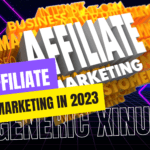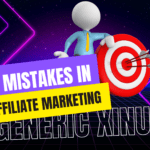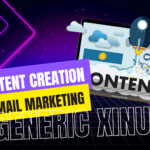TABLE OF CONTENT:
- Genius Strategy 1: Build a High-Quality Email List
- Genius Strategy 2: Personalization and Segmentation
- Genius Strategy 3: Craft Irresistible Subject Lines
- Genius Strategy 4: Provide Value with Every Email
- Genius Strategy 5: Use Automation Smartly
- Genius Strategy 6: Leverage Visuals and Interactive Content
- Genius Strategy 7: Craft Engaging Calls-to-Action (CTAs)
- Genius Strategy 8: Optimize for Mobile Devices
- Genius Strategy 9: Incorporate Storytelling
- Genius Strategy 10: Re-engage Dormant Subscribers
- Conclusion
Genius Strategy 1: Build a High-Quality Email List
Identifying Your Target Audience
To build an email list that converts, you need to understand who you are targeting. Without a clear understanding of your audience, your emails may fall flat. Here’s how to refine your audience research:
- Define Your Niche: Start with a deep dive into your affiliate niche. If you’re promoting health supplements, your audience might include fitness enthusiasts, people with specific health conditions, or those looking to improve their overall well-being.
- Use Data to Build Personas:
- Gather demographic data such as age, gender, income, and location.
- Explore psychographics: interests, values, goals, and challenges.
- Identify behaviors such as online habits, spending patterns, and preferred communication channels.
- Conduct Surveys or Polls: Ask your current followers or customers what they want and need. Use tools like Google Forms or social media polls to collect insights.
- Leverage Analytics: Use analytics tools (Google Analytics, social media insights, etc.) to identify trends in your audience’s behavior.

Effective Ways to Grow Your Email List Organically
Building an organic email list means attracting subscribers who are genuinely interested in what you offer. Focus on providing value in exchange for their information:
- Create Irresistible Lead Magnets:
- Offer free guides, checklists, or templates relevant to your niche. For example, if you’re an affiliate for financial software, a lead magnet like “The Ultimate Guide to Budgeting” can attract potential subscribers.
- Host giveaways or contests that require email sign-ups for participation.
- Design Attention-Grabbing Sign-Up Forms:
- Include clear headlines, minimal fields, and persuasive copy (e.g., “Join 10,000 others in mastering [topic]!”).
- Use exit-intent popups to capture users who are about to leave your site.
- Optimize Your Landing Pages:
- Design dedicated landing pages with no distractions, a clear value proposition, and an engaging call-to-action (CTA).
- Include testimonials or social proof to build credibility.
- Network and Collaborate:
- Partner with other brands or influencers to co-create resources or campaigns that require email sign-ups.
Tools and Techniques to Manage Your Subscriber Database
Managing your list effectively ensures high engagement and email deliverability. Here are the best practices and tools:
- Segment Your Subscribers: Divide your list based on interests, behaviors, or demographics. For example:
- New subscribers: Send them a welcome series.
- Engaged subscribers: Target them with exclusive offers.
- Inactive subscribers: Re-engage them with win-back campaigns.
- Regularly Clean Your List:
- Remove invalid or unresponsive email addresses to improve open rates and sender reputation.
- Use email verification tools like ZeroBounce or NeverBounce.
- Use Comprehensive Email Marketing Platforms:
- Platforms like ActiveCampaign or Mailchimp offer tagging, automation, and advanced segmentation capabilities.
Genius Strategy 2: Personalization and Segmentation
Why Personalization Drives Engagement
Personalization works because it shows subscribers that you understand their needs. Generic emails may feel like spam, but tailored content resonates deeply.
Here’s why personalization matters:
- It Builds Relationships: Addressing recipients by their name or referencing their past interactions fosters trust.
- Improves Metrics: Emails with personalized subject lines are 26% more likely to be opened.
- Enhances Loyalty: Subscribers are more likely to remain loyal when they feel valued.

How to Segment Your Audience for Maximum Impact
Segmentation ensures that the right message reaches the right people at the right time. Here’s how to create impactful segments:
- Behavioral Segmentation: Track actions like:
- Clicking a specific product link.
- Downloading a free resource.
- Completing a purchase.
- Demographic Segmentation: Tailor campaigns based on demographic details such as age, location, or occupation. For example, young professionals might prefer time-saving tools, while retirees might favor health-related products.
- Lifecycle Stage Segmentation: Identify where each subscriber is in the customer journey:
- New subscribers: Send introductory content.
- Repeat buyers: Offer loyalty rewards.
- Dormant subscribers: Use re-engagement campaigns.
Tools to Implement Advanced Personalization Techniques
Achieving personalization at scale requires leveraging technology. Here are some tools:
- CRM Platforms: Use tools like HubSpot or Salesforce to manage customer relationships and gather valuable data for personalization.
- Behavioral Triggers: Set up automated emails that react to subscriber actions (e.g., cart abandonment, link clicks). Klaviyo and Drip excel in this area.
- Dynamic Content Platforms: These tools allow you to customize sections of your emails based on subscriber data. ActiveCampaign and Mailchimp offer this feature.
Genius Strategy 3: Craft Irresistible Subject Lines
The Psychology Behind Subject Lines
Your subject line is the first impression your email makes. To ensure it hooks your audience:
- Invoke Curiosity: Pique interest with phrases like:
- “You won’t believe this secret…”
- “Have you tried this yet?”
- Leverage Urgency: Create a sense of FOMO (Fear of Missing Out):
- “Only 24 hours left to grab this deal!”
- “Don’t miss out—limited stock available!”
- Promise Value: Clearly state the benefit the recipient will get:
- “Save time and money with this exclusive tip.”

Examples of High-Converting Subject Lines
Tailor your subject lines to your audience and goals. Here are more examples:
- For Promotions:
- “Flash Sale: 50% Off Ends Tonight!”
- “Your Exclusive Discount Code Inside!”
- For Engagement:
- “Is this your biggest challenge right now?”
- “We’d love to hear your thoughts!”
A/B Testing for Subject Line Optimization
Continuous testing ensures improvement. Here’s a structured process:
- Define a Hypothesis: For example, “Subject lines with emojis will increase open rates by 10%.”
- Run Controlled Tests: Split your audience into two groups and send each a different subject line.
- Measure Results: Focus on open rates, but also monitor click-through rates to gauge overall effectiveness.
Genius Strategy 4: Provide Value with Every Email
Why Providing Value is Essential
In the crowded space of email marketing, value-driven content helps you stand out. Emails that focus solely on promotions can lead to higher unsubscribe rates, while those offering genuine benefits build trust and loyalty.
Key reasons why value matters:
- Fosters Long-Term Relationships: Subscribers are more likely to stay on your list when they see consistent value.
- Boosts Engagement Rates: Valuable content encourages readers to open, click, and interact with your emails.
- Positions You as an Authority: Educational and insightful emails establish your expertise in your niche.
Types of Valuable Content to Include in Emails
Educational Content:
- Tutorials and How-To Guides: Teach your audience how to achieve a goal using your affiliate product.
- Example: If you promote a meal planning app, send a guide like “5 Steps to Create a Perfect Weekly Meal Plan.”
- Tips and Tricks: Share actionable advice related to your niche.
- Example: “Top 10 Hacks to Boost Productivity Using [Affiliate Product].”
- Tutorials and How-To Guides: Teach your audience how to achieve a goal using your affiliate product.
Entertaining Content:
- Share personal anecdotes, light-hearted stories, or even memes that relate to your niche.
- Example: If your audience loves fitness, share a humorous take on workout bloopers alongside tips to avoid them.
Exclusive Offers or Perks:
- Provide early access to affiliate product deals, exclusive bonuses, or special discounts.
- Example: “As a valued subscriber, enjoy 20% off [Affiliate Product] this weekend only!”
Success Stories and Testimonials:
- Highlight stories of how others have benefited from the affiliate product.
- Example: “Meet Jane: How She Saved $500 with [Affiliate Tool].”
Balancing Promotions with Value
To maintain subscriber interest, use the 80/20 Rule:
- 80% Informative Content: Deliver value through education, insights, and entertainment.
- 20% Promotional Content: Position your affiliate product as a natural solution to their problems.
Example of Balanced Email Content:
- Subject Line: “Struggling to Stay Organized? We’ve Got You!”
- Body Content: Share a short guide on productivity tips, then introduce an affiliate product like a project management tool as an additional resource.
- CTA: “Discover How [Product Name] Can Simplify Your Workflow.”
Case Study: How Value-Driven Emails Increase Affiliate Sales
Scenario:
An affiliate marketer promoting a health supplement sent weekly emails offering:
- Recipes featuring the supplement.
- Tips on improving overall wellness.
- A case study showing the benefits of consistent supplement use.
Results:
- Open rates increased by 35%.
- Affiliate sales doubled as subscribers saw the product as integral to the advice provided.
Genius Strategy 5: Use Automation Smartly
What Email Automation Can Do for You
Email automation allows you to stay connected with subscribers at the right time, without manual effort. For affiliate marketers, automation can:
- Save Time: Pre-schedule emails to send automatically based on triggers or timing.
- Boost Engagement: Deliver timely and relevant messages that align with subscriber behavior.
- Increase Sales: Guide subscribers through a journey that leads to affiliate purchases.

Examples of Effective Automated Email Sequences
Welcome Sequence:
- Goal: Introduce your brand and build rapport with new subscribers.
- Structure:
- Day 1: Welcome email with an introduction and free resource.
- Day 3: Email sharing your story and how your affiliate products fit into it.
- Day 5: Showcase benefits of subscribing (e.g., exclusive discounts or content).
Educational Series:
- Goal: Educate subscribers about a topic while subtly promoting your affiliate product.
- Structure:
- Email 1: Explain the problem (e.g., “Why Most People Fail at X”).
- Email 2: Introduce potential solutions.
- Email 3: Offer your affiliate product as the best solution.
Re-engagement Campaigns:
- Goal: Win back dormant subscribers.
- Structure:
- Email 1: “We Miss You! Here’s What’s New.”
- Email 2: Share a special offer.
- Email 3: Ask for feedback if there’s still no engagement.
Tools to Implement Email Automation
Here are some of the best platforms for setting up email automation:
- ActiveCampaign: Known for advanced segmentation and workflow capabilities.
- ConvertKit: Designed for creators, with a focus on simple automation.
- Drip: Ideal for eCommerce and affiliate marketers, offering robust tools for behavior-based triggers.
Tips for Creating Successful Automation Campaigns
- Map Out the Customer Journey: Visualize the steps a subscriber takes from joining your list to purchasing an affiliate product.
- Segment for Relevance: Ensure automation sequences cater to specific subscriber groups.
- Monitor and Optimize: Regularly review performance metrics like open rates, click-through rates, and conversions to refine your workflows.
Genius Strategy 6: Leverage Visuals and Interactive Content
Why Visual Content Enhances Email Marketing
Visual content significantly boosts engagement by breaking up text and appealing to different learning styles. Research shows that emails with visuals see a 42% higher click-through rate than text-only emails. Visuals help by:
- Grabbing Attention: Images, GIFs, and videos catch the eye more effectively than plain text.
- Conveying Complex Information: Infographics or charts simplify complex ideas, making them easier to digest.
- Enhancing Recall: People are more likely to remember information paired with visuals.

Types of Visual Content for Affiliate Emails
-
Product Images and Demos:
- Use high-quality visuals showcasing the affiliate product in action.
- Example: For a kitchen gadget, include a video demonstrating its unique features.
-
Infographics:
- Simplify data or processes related to the product.
- Example: “5 Steps to Financial Freedom” with your affiliate product as a key solution.
-
Interactive Elements:
- Add clickable surveys, quizzes, or polls. These not only engage users but also help you gather insights.
-
GIFs:
- Use subtle animations to add fun or emphasize key points. For example, a GIF of a discount countdown creates urgency.
-
User-Generated Content (UGC):
- Include photos or videos from satisfied customers using the affiliate product.
Best Practices for Adding Visuals to Emails
- Optimize for Load Times: Compress images and videos to ensure fast loading, especially for mobile users.
- Use Alt Text: Include descriptive alt text to make visuals accessible to visually impaired readers and ensure clarity if images don’t load.
- Maintain Consistency: Ensure visuals align with your branding for a professional look.
- Limit Visual Overload: Avoid cluttering emails with too many visuals; balance them with concise text.
Tools for Creating and Optimizing Visual Content
- Canva: Easy-to-use for creating professional-looking images and infographics.
- Giphy: Great for finding or creating GIFs.
- Loom: Ideal for recording quick product demos or walkthrough videos.
- Unsplash or Pexels: Free resources for high-quality stock images.
Genius Strategy 7: Craft Engaging Calls-to-Action (CTAs)
Deep Dive into CTA Placement and Design
The success of your email often hinges on the effectiveness of your CTAs. The goal is to guide readers toward the next step seamlessly.
Key Placement Strategies:
- Above the Fold: Place a CTA early in the email for readers who prefer quick action.
- Mid-Content: Insert a CTA where it naturally follows relevant information.
- At the End: Conclude with a CTA to capture readers who have consumed the full email.
Design Tips:
- Button Styles: Use vibrant colors that contrast with the email background.
- Whitespace: Surround CTAs with whitespace to make them stand out.
- Action-Oriented Language: Instead of generic phrases like “Click Here,” use specifics like “Start Your Free Trial” or “Get 50% Off Now.”

Psychological Triggers in CTA Copy
Leverage psychological principles to create irresistible CTAs:
- FOMO (Fear of Missing Out):
- Example: “Offer Ends Tonight—Act Now!”
- Social Proof:
- Example: “Join Thousands Who’ve Transformed Their Lives with [Product Name].”
- Exclusivity:
- Example: “Unlock Your VIP Access Today.”
Genius Strategy 8: Optimize for Mobile Devices
Design Principles for Mobile-First Emails
With mobile devices accounting for over 60% of email opens, your designs must prioritize the mobile experience.
Key Design Principles:
- Responsive Layouts: Ensure emails adapt seamlessly to various screen sizes.
- Shorter Subject Lines: Keep subject lines under 40 characters for mobile preview panes.
- Scannable Content: Use short paragraphs, bullet points, and clear headings.

Testing Your Mobile Optimization
Testing ensures a consistent experience across devices. Use these tools:
- Litmus or Email on Acid: Preview emails across multiple devices and email clients.
- Browser DevTools: Simulate mobile views directly in your browser during the design phase.
Advanced Tactics for Mobile Optimization
- Touch-Friendly CTAs: Make buttons large enough for easy tapping, and ensure spacing prevents accidental clicks.
- Leverage Location-Based Content: Use geo-targeting to tailor content for mobile users based on their location.
Genius Strategy 9: Incorporate Storytelling
Advanced Storytelling Techniques
- Use Relatable Characters: Center your stories on relatable figures who reflect your audience’s struggles and aspirations.
- Incorporate Conflict and Resolution: Highlight challenges and how the affiliate product provides a solution.
- Show, Don’t Just Tell: Use vivid language and visuals to immerse readers in the narrative.
Step-by-Step Guide to Writing Compelling Stories
- Identify the Problem: Open with a pain point your audience can relate to.
- Example: “Struggling to keep track of expenses?”
- Introduce the Solution: Share how the affiliate product solves the problem.
- Example: “Here’s how [Product Name] can simplify your budgeting.”
- Include a Call-to-Action: Encourage readers to take the next step.
- Example: “Click here to start your journey to financial freedom today!”
Using Stories to Overcome Objections
Stories can address common objections, such as:
- Cost Concerns: Share testimonials emphasizing the long-term value of the product.
- Skepticism: Include case studies or real-life examples of success.
Genius Strategy 10: Re-engage Dormant Subscribers
Deep Dive into Win-Back Campaigns
Exclusive Offers:
- “We’d love to have you back! Enjoy 30% off your next purchase.”
Engaging Content:
- Share a collection of your best-performing emails to remind subscribers of your value.
Re-confirm Subscription:
- Use an email like: “Do You Still Want to Hear from Us? Click Below to Stay Connected.”
Creating a Re-Engagement Timeline
- At 30 Days of Inactivity: Send a friendly nudge with a recent resource or offer.
- At 60 Days of Inactivity: Highlight what they’re missing out on.
- At 90 Days of Inactivity: Offer an incentive to re-engage or remove them from your list.
Congratulations
you’ve just unlocked the secrets to boosting your affiliate sales with smart, strategic email marketing! Whether you’re a seasoned marketer or a curious beginner, these 10 strategies are your roadmap to connecting with your audience in meaningful ways, building trust, and driving results.
Remember, email marketing isn’t about spamming inboxes or hoping for random clicks. It’s about crafting messages that matter, delivering value, and showing your audience how the affiliate products you recommend can genuinely improve their lives.
From creating irresistible subject lines to leveraging automation, using visuals, and re-engaging subscribers, you now have the tools to transform your campaigns into powerful engines of growth. Each strategy builds on the next, giving you a well-rounded approach that not only boosts sales but also nurtures long-term relationships with your audience.
Here’s the best part: you don’t have to be perfect from the start. Experiment, learn, and grow. Email marketing is a journey, and every email you send is a chance to refine your skills and get closer to your goals.
So, what’s next? Take that first step. Start building or refining your email list, plan your content, and implement the strategies that resonate most with your style and audience. With persistence, creativity, and these proven techniques in your toolkit, your affiliate marketing success is just an email away.
Now, go ahead and make your emails shine—you’ve got this! And if you ever need a helping hand or a little extra inspiration, I’m here to guide you every step of the way. Let’s make your affiliate dreams a reality!
FAQ Section (Frequently Asked Questions)
Email marketing is the process of sending targeted and personalized emails to a list of subscribers. For affiliate sales, it’s an essential tool because it allows you to build trust, share valuable content, and directly promote affiliate products to a receptive audience. Unlike social media, where algorithms can limit reach, email ensures your message lands directly in your subscribers’ inbox.
To build a strong list:
- Create a compelling lead magnet (e.g., eBooks, guides, or free trials) relevant to your niche.
- Use signup forms on your website, blog, or landing pages.
- Promote your lead magnet on social media and other platforms.
- Avoid purchasing email lists; focus on organic, engaged subscribers.
Consistency is key. Start with 1–2 emails per week, depending on your content and audience preferences. Avoid overwhelming your subscribers, but stay frequent enough to remain top-of-mind. Always prioritize quality over quantity.
A: There doesn’t appear to be a limit on the number of prompts you can sell. You can utilize all the pre-loaded prompts and add your own as well.
Follow these tips:
- Use a reputable email marketing platform.
- Avoid spammy words like “FREE!!!” or excessive capitalization.
- Include an unsubscribe option to comply with email regulations.
- Regularly clean your list to remove inactive or invalid emails.










I’ve been following your blog for quite some time now, and I’m continually impressed by the quality of your content. Your ability to blend information with entertainment is truly commendable.
Thank you for the auspicious writeup It in fact was a amusement account it Look advanced to more added agreeable from you By the way how could we communicate
Wow amazing blog layout How long have you been blogging for you made blogging look easy The overall look of your web site is magnificent as well as the content
Wow superb blog layout How long have you been blogging for you make blogging look easy The overall look of your site is magnificent as well as the content